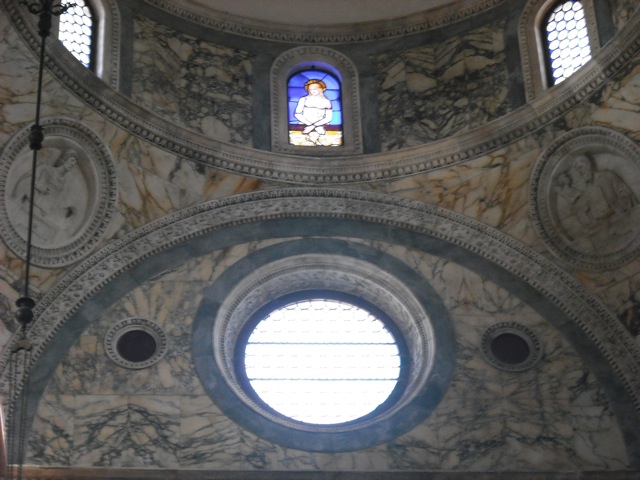I am currently on the run. No, I am not fleeing the authorities in Rome who are busy suppressing rioters. No, I am not Paul McCartney and the Wings. In fact, I have done nothing criminal. I am just touring the North of Italy (right now in the region called Veneto) and we’re not staying in any one place for long. It is interesting for many reasons not only architectural. The culture, politics etc. of this area of the “country” are fascinating. In fact, Northern Italy is kind of like the antebellum South.
But enough of that. Let us return to architecture. Since I was in Vicenza today and just recently arrived in Verona (I ate dinner with Two Gentlemen from Verona), I have not seen many churches since Venice. So I decided to feature a church that I saw on Sunday as opposed to one I saw today. But that’s acceptable, right? I’m on the run and I don’t have much time. Got to take what you can get.
On Sunday morning (after Mass in the Basilica di San Marco in Venice), we took a lightning fast tour of some of the churches in the area of San Marco. There aren’t as many as in Rome, but there are a lot. Although many of them are still Gothic, some are Renaissance and later (San Marco would be mostly Byzantine, I’d say). Some are even done by Andrea Palladio, one of the most famous northern architects of the Italian Renaissance. Two such churches are San Giorgio Maggiore and Il Redentore, neither of which are today’s church. Palladio is too easy to talk about and too easy to over analyze. My whole point in this series is to help all of you take a closer look at good church architecture so your appreciation of the beauty around you will increase. I hope I am succeeding.

Anyway, the church I am featuring is a small church by the name of Santa Maria dei Miracoli, which as some of you may guess, means “Saint Mary of the Miracles”. It is so named because of a miraculous icon which is housed there. It was built (am I actually talking about architects now? I must have too much on my mind right now) by the great Venetian architect Pietro Lombardo at the beginning of the Renaissance (although it MAY have been the very end of the Middle Ages…you never know with these time distinctions.) Let me tell you a little bit about it’s architecture.
First of all, the main approach from Piazza San Marco is across a bridge the ends in a piazzatta on the back of the church. This was a little odd, but we eventually found our way to the front. Being at the juncture of the Middle Ages and the Renaissance, the facade exhibits some elements of both.

For instance, there are modified Ionic pilasters that articulate the facade, but the rhythm of the pilasters of very Italian Gothic. Another church like this is Santa Maria Novella in Florence. Really, almost all of the Medieval cathedrals in Italy have a small arcuated pilaster system (arcuated means with arches) or something similar. This one just happens to employ the ionic order which is being revived in the Renaissance. Another element that points to this juncture is the rounded top of the facade. Traditional Venetian Gothic churches would have a central bay of the facade with a semicircle crowning it and one bay on each side bay topped with a quarter circle. SMdM (Santa Maria dei Miracoli) is only one bay (you will see why later) but it still has the semicircular element on top. However this time, it has become a Renaissance, or proto-Renaissance, pediment. It has a cornice line all around it and it has statuary on pedestals at the corners and at the top like most Renaissance and Baroque churches. My main point here is that there was a fusion of the traditional Venetian with the innovation of the Renaissance.

Let us now enter the church. The first thing to notice is that the church is indeed one bay wide. It is only a nave, no side aisles. The single bay on the facade begins to make sense. when you enter, you find yourself in a small vestibule which is really just the area under the choir loft.

The ceiling of this space is heavily coffered and there is a ladder to the loft, but there doesn’t appear to be a door. Could it be hidden by one of the coffering panels? Perhaps. (Ok, now I’m talking like one of the professors here…)

There are a couple more things I would like to talk about before catching up on my rest. The first is the sanctuary. It is raised on a high platform with a central staircase leading up to it. This is a very unique way of expressing the purpose and hierarchy of the space. I’ve really never seen it before. I’m sure it happens, but this was the first time I had experienced it. At the top, on either side, was a pulpit with an eagle bookstand carved from stone.

The Eagle, a symbol of St. John, is hardly ever seen in Venice. They prefer St Mark’s Lion. However, they still see fit to put it on their pulpits. They are good at reaching across the aisle. The altar (the original one) is in the back of the sanctuary after a small schola cantorum (a half-walled off section for choir/clerics).

The interesting thing about many Venetian churches is that the altar is underneath a dome and is never at the crossing. This of course indicates that the dome is not at the crossing. Compare this to Roman churches and you will see that the dome is often over the crossing and not over the altar, unless the altar is at the crossing which pretty much only happens in St. Peter’s. In SMdM, there is a dome and it is over the altar which is not at the crossing. This church is very particularly Venetian.
One of the main symbolic themes, which one also sees all over Venice, is the cross made from roundels, or more or less a cross. This occurs on the facade and on the sanctuary especially. It is an interesting motif and something that reminds me of the Middle Ages, but I might be wrong.
The last thing I would like to point out is the metal tie rods that run from the springing of the vault. a vault this big requires very thick walls to be able to support the forces from the arched form, but it appears that SMdM does that have sufficient walls and instead must be held up with tie rods. In fact, Venice is full of them. It is probably in this case not only because of the forces from the arch but also because Venice is built on wooden piles stuck in a lagoon. Not helpful for building vaulted spaces.
That is an overview of some of the beauty that is possible to find among the tourists and the dirty grayness of the city. It fuses the old with the new in an amazing way and is very nice to behold. You can tell that I’ve actually had to study this building because I have a lot to say about it and not a lot of picture. Don’t tell anyone, but there are some flaws in the design. Fortunately, the main ideas are definitely coherent and overall it is a well conceived building.
Any requests just let me know. I am back in Rome by Monday. I will be in Ravenna, Bologna, Verona and Mantua.
Ciao ciao for now.






1 thought on “Le Chiese delle Cittá: Santa Maria dei Miracoli”
Nathaniel,
Am I to understand that the disease of thinking and speaking of architects and talking like a professor is chronic? I’ve already begun… >.<